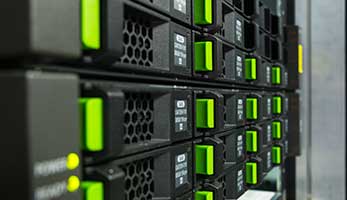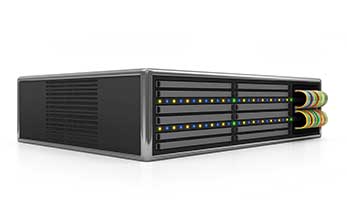
The video recording solution is just as important as the cameras
Recording the video that is collected by surveillance cameras is, of course, very important and needs to be planned right. There are many factors that come into play with video recording. It is important to know how long you want to be able to keep the collected video for. Beyond that we need to know how much motion on average will be within the surveillance area, as motion will affect the file sizes that are being recorded. Finally when designing a system it is important to know the amount of cameras, so we don’t run into bottlenecks with the data being recorded.
So what are your options?
These servers are the same or similar servers that corporations use to keep their data on and to run applications. These servers can be expanded virtually endlessly. Surveillance servers are great for larger installs or specialized installs that require video plugins to be run. The server runs software that communicates with the cameras and collects all the video as required. The great thing about these servers is that you are not limited by the amount of cameras that they can handle and record from. Storage can also be expanded by adding more hard drives or adding expansion modules, depending on the new storage requirements.
Embedded Video Surveillance Servers are usually best for smaller applications. These servers come in preset configurations, which are usually 4 cameras, 8 cameras, 16 cameras and 32 cameras. These servers are great as they offer everything needed for basic surveillance, are very reliable and have a small footprint. They also have the availability that the storage can be expanded either via external hard drives or by adding more hard drives internally. These servers oftentimes also offer plug and play capabilities with cameras, so the camera is wired directly into the server.
This solution is the best of two worlds. We offer hosted surveillance products that allow you to have a video surveillance solution on premises that is hosted in the cloud. With this solution you don’t have to buy all the expensive equipment up front, find space for it and make sure it stays unharmed. We can add as many cameras as required on site and you are able to control how long you want to keep your recorded surveillance video footage for. Any applications that may be required are also able to run on our servers and you have access to it wherever you go. All maintenance is covered by us as well, so you no longer have to dread that anything may break.
Learn more about Surveillance from our Blog
Things to consider
Video surveillance servers are great when they are correctly designed for the environment they are placed in. Many factors such as amount of cameras, resolution of the cameras, video retention requirements, motion in the area and more come into play for the correct design. Here we list a few to make you more familiar with the design requirements of these servers.
Amount of Motion on site:
Video is compressed using H.264 as a popular codec. This technology allows us to minimize the file size of the video that is collected on site. This is done by using different frame types, which are put on top of each other to create the final image. Imagine it as a template image of the scene, and someone is walking through it. The area itself does not change, but the pixels where the person walks are changing. As such the camera will only record the motion of the person and keep the remainder of the image the same, which results in 10 images of the person in different spots, which are put on top of the scene image. This way we only have to record 1/10 or even less of the scene instead of having a full image every single time. Minimizing storage. The more motion there is on site however, the less effective this codec becomes and the larger the file sizes become. That is why it is important to know how much traffic usually comes through an area to measure the effectiveness of the codec within the area.
Physical environment the server is placed in:
The physical environment that the server is placed in is absolutely crucial to ensure reliability and longevity. If the server is constantly forced to overheat, because no air is circulated in the room, or if it is extremely dusty, this will force the server to shut down and will also harm the server over time, which will see it failing much sooner than it should. Furthermore the uptime both the cameras and the server almost need to be guaranteed. So you cannot afford a power failure that knocks our your entire infrastructure. Lastly, theft is also an issue for these devices. If someone does break in and gets a hold of your server, the surveillance solution helped you absolutely nothing in that case. Proper placement of these servers is absolute key for this.
Amount of cameras placed on site & resolution of these cameras:
The amount of surveillance cameras placed on site plays a huge role on the proper design of a surveillance server. Many servers have a set number of cameras that they are limited to, whereas others claim that they are virtually unlimited. The amount of cameras and resolution of these cameras matters because of bandwidth requirements. Imagine a tunnel that has 2 lanes both ways. This tunnel can only allow a set number of cars to drive through it at any given time. Otherwise you will have traffic jams and even crashes. The same thing happens with data if you are trying to pump more through it than it can handle. Unfortunately in networking the other “cars” or data don’t stop. Having a camera might take a set amount of bandwidth, but once you have 32 cameras, that is an entirely separate beast, which the storage array, the networking adapters, the wiring and the entire infrastructure will have to support. If it is not supported, laggy video oftentimes is a result of it, failure to record of the server and more. The higher the resolution of the camera, the larger the files that are collected by it, and as such a few high resolution cameras may account to the same data that many low resolution cameras might struggle to achieve. There are trade offs which each camera placed in a building, as such the design will have to be meticulously thought out to ensure its capability across the board.







